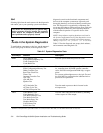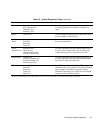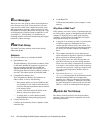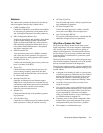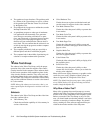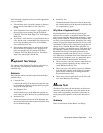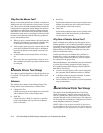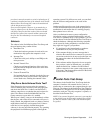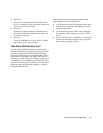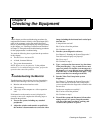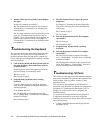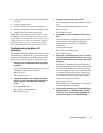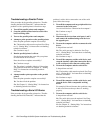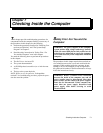
5-16 Dell PowerEdge 6100/200 System Installation and Troubleshooting Guide
Subtests
The subtests in the Parallel Ports Test Group and the port
functions they confirm follow:
•
Internal Test
Checks several internal functions of the parallel port.
•
External Loopback Test
Tests the functionality of the control lines through an
external loopback connector, if an external loopback
connector is available.
•
External Interrupt Test
Tests the parallel port’s ability to generate interrupts
from all possible sources, if an external loopback
connector or printer is available.
•
Printer Pattern Test
Tests a printer and tests the parallel port’s ability to
send a pattern to the printer, if connected.
Why Run a Parallel Ports Test?
If the diagnostics does not recognize the computer’s par-
allel port, enter the system setup program and check the
Parallel Port ECP-DMA category to see if the port has
been disabled. The subtests in the Parallel Ports Test
Group cannot test a port unless it is enabled.
When a port is faulty, it may not be immediately evident
that the port, and not the device connected to the port, is
faulty. Instead, the peripheral (such as a printer) might
behave erratically or not operate at all. If the external
device is not properly installed through the software, it
also may not function properly. Try operating the periph-
eral from different programs or through the operating
system. If it still does not work, you can eliminate the
software setup as the cause of the problem.
Another possible cause for errors is the external device.
Use the documentation that came with the peripheral to
troubleshoot it and confirm that it is working properly.
Most printers have a self-test.
After you eliminate incorrect system configuration infor-
mation settings, peripheral malfunctions, and software
errors as potential causes of port problems, you can run
the subtests in the Parallel Ports Test Group to check the
hardware. Although the following symptoms can be
caused by faulty peripherals or software errors, they
might also suggest a port problem:
•
If a peripheral works intermittently or produces
intermittent errors, the port may be faulty.
•
If the computer displays an error message that is
related to the external device connected to a port, but
corrections to the device do not resolve the error, run
the appropriate subtest in the Parallel Ports Test
Group.
•
If the software and the diagnostics do not recognize
that you have a parallel port, you should check the
Parallel Port ECP-DMA category in the system setup
program, and if necessary, run the appropriate sub-
test in the Parallel Ports Test Group.
S
CSI Devices Test Group
The subtests in the SCSI Devices Test Group check the
functionality of up to four small computer system inter-
face (SCSI) host adapters and all the SCSI devices
attached to them.
NOTES: Before conducting these subtests on CD-ROM
drives, insert a CD with audio and data tracks (such as a
multimedia CD) into each CD-ROM drive. All of the sub-
tests require a CD with data tracks.
If a CD-ROM drive is empty or if it contains a CD that
does not have the required data or audio tracks (depend-
ing on the subtest[s] being conducted), the subtest(s) will
fail.
Subtests
The subtests in the SCSI Devices Test Group and the
drive functions they confirm follow:
•
Internal Diag. Test
Causes the device to run its internal self-test.
•
Seek Test
Checks the device’s ability to search for a specified
track on the device and to position its read/write
heads to all tracks.



